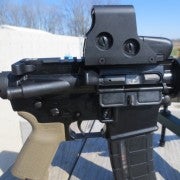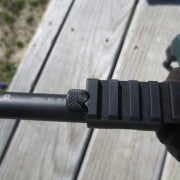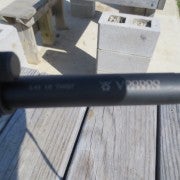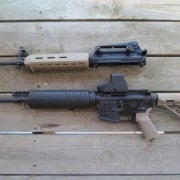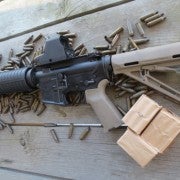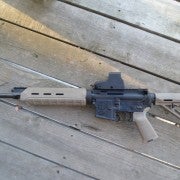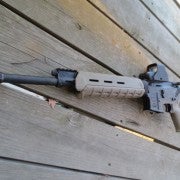This review could not have come at a worse time to a better company & product. TFB requested the Adams Arms upper when 7n6 was plentiful. With the recent ban on cheap MilSurp ammo, the allure of 5.45 may be waning, but as a DI guy I walked away plenty impressed with the Adams Arms piston kit.


The Adams Arms 5.45 upper mounted to a standard AR-15 lower compared to a standard mid-length upper with carry handle and FSB.
I never quite understood why 5.45 did not catch on as much as 7.62×39. It was consistently much cheaper, similar ballistics to 5.56, and lower recoil for like performance. During the “panic” 5.45 was still easily available and AK74’s did not see any where near the same inflation. Yet, many 5.45 kits have come onto the market, but only Adam’s has had any staying power. The Spike’s Tactical, Smith & Wesson, and other have waned. I would suspect this has much to do with Adams Arms’ piston system.
The Adams Arms’ 5.45 Upper
I was fortunate to be stationed next to Adams Arms at ShotShow 2014. There, I discovered that Adams was just releasing a complete mid-length 5.45 upper receiver kit. Keen to try the mid-length over the already released carbine version, I requested one for review. Adams sent me one of the first off of the production line.
Even though upper receivers do not have to be shipped to a FFL, Adams took care to ship in a nondescript box. The upper was packaged in a clear thick plastic bag, contained in purpose-made styrofoam padding. Included in the kit was the complete upper receiver (no iron sights, standard mid-length shielded handguards, 5.45 30-round magazine, and an increased power hammer spring for reliable ignition of old surplus ammunition.
The upper receiver was a standard matte black color with an even finish. The one-piece bolt and piston op-rod had a slick finish with a nice metallic sheen. The barrel is 16″, 1/8″ twist mid-length, government-profile, with a standard A2-style flash-hider. Adams uses a proprietary “LifeCoat” finish on the barrels and bolt for increased hardness and resistance to corrosion critical for long-term use with 7n6 and similar ComBloc ammunition. The barrels are supplied by their sister division, VooDoo Innovations.

Close-up of the gas block and barrel showing the VooDoo markings. You can see some residue from the piston vent after about 500 rounds.
For the review, I opted to use one of my trusty SAA lowers (OEM’d by Aero Precision). It is a standard AR-15 lower with a Del-Ton complete lower parts kit and H1 buffer. It has been flawless in any put on the receiver to date. To start, I did not install the increased power hammer spring as I wanted to see how reliable it would be with standard lower parts.
The Adams Arms upper went on tight! The first time it was mounted, I had to use a brass hammer to push the pins through. After two more removals and re-mountings the upper fit on the lower fit and pins were removable by hand. As you may expect from this effort, there was no play between the two receivers.

The upper receiver with EOTech mounted. Note there is no light gap between the receivers. Solid fit!
It is notable that since Adams uses a piston, the bolt is spring-loaded to push forward during the unlocking phase. When assembling the two receivers, the shooter may have to remember to push the entire BCG forward so it does not stick out from behind the upper for easy reassembly.
The Adams Arms gas block is fully adjustable with four settings:
- “High” – Normal operations, non-suppressed. (I ran the review at this setting)
- “Low” – For suppressed shooting.
- “Off” – Manual action cycling required.
- “Remove” – Dis-assembly and cleaning.
The upper comes lubricated, but I like to run my rifles wet whenever possible. I added a bit more BreakFree CLP, broke open a tin of 7n6 and headed to the range.
A Lot of 7n6 Died to Bring You This Review…
For the range session, I mounted my trust EOTech for zeroing and general shooting. For accuracy testing, I used a Caldwell 7-Rest and Gander Mountain zeroing targets set up at 50 and 100 yards.
The manual of arms is the exact same for the 5.45 upper, which made it easy to get comfortable with quickly. Recoil is pleasant, in line with what one would expect from any mid-length upper. Shooting the 5.45 and a mid-length DI 5.56 back-to-back did not yield any appreciable differences on my “shoulder-meter”
Using surplus 7n6 and some Wolf I was able to scrounge a local sporting goods store, I set out to zero the rifle. At 50 yards, the upper came in over 20″ below my ACR and AR-15s (which are within a few inches of each other at 100 yards). Unusual, but with the optic adjusted the point of impact did not shift during the multiple testing days.
I used the 7n6 to originally zero the rifle. Shooting slowly and methodically, the surplus ammo came in to average 3 MOA groups across strings of fire, surprisingly good for surplus ammunition. The smallest group was 1.3″ across and largest was 5″. There was no noticeable difference with the Wolf.

The smallest group at 100 yards. I completely bonked the fifth shot and called it in my book.
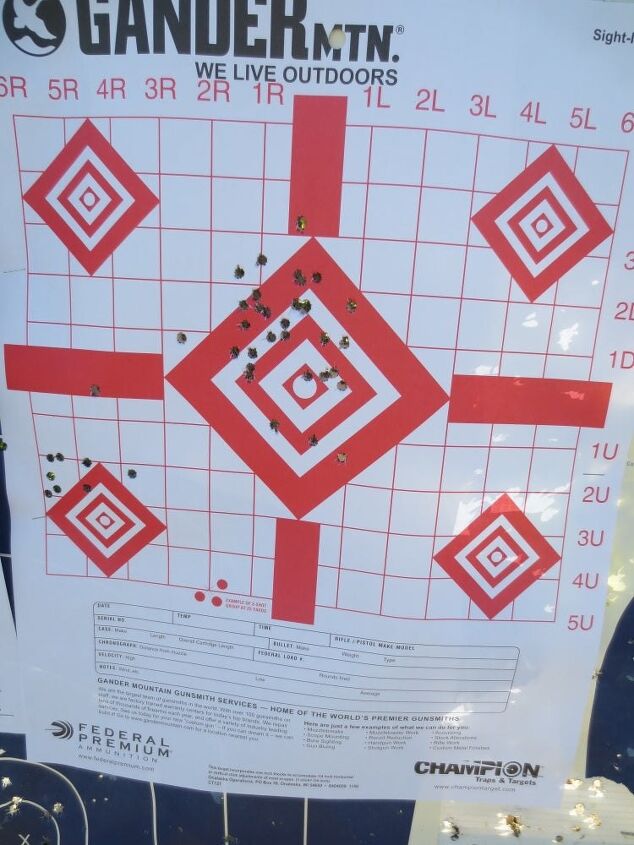
Having “fun” during slow-fire with four different shooters. Here you can see what happens when you press on a non-free-floated barrel. Very consistent performance across multiple people.
Functionality
Note- I opted to run the gun hard and experiment to see what works. When used per Adam’s manual with either the purpose-built 5.45 magazine or the modified PMAG, functionality was perfect. The synopsis below is purely my experimentation.
As I noted earlier, I originally shot the upper with the stock AR-15 hammer just to see how reliable ignition would be. On my first range trip using the stock spring, I experience a light hammer strike about 1 out of 30-40 rounds across 400 rounds. Not bad considering the ammunition was made long before the rifle. After switching to the increased power spring, the remaining 350-400 rounds ignited 100%. If you plan on shooting the upper often, use the high-power spring. However, it did increase my 5lbs 10oz stock trigger pull to about 6lbs 7oz.
The real issue with 5.45 uppers is magazines. Compared to 5.56, 5.45 has a higher case taper, which when used with non-tilting followers can cause failures to feed “nose-dive” malfunctions when the rounds don’t feed fast enough. To test this, I used five different magazines outlined below:
- Included 30-round 5.45 Magazine
- Modified Gen 2 PMAG (per MrGunsnGear’s video here)
- Stock PMAG Gen 2 (Window)
- Stock PMAG Gen 3 (Window)
- Brownell’s STANAG Mag w/ Level Follower
Using the stock 5.45 magazine and the modified PMAG, functionality was 100%. I tested various round counts in the standard mags and below are my findings of reliable function. The Brownell’s metal magazine had more issues. I would suspect this is due to the increased friction between the rounds and the metal magazine body.
- (15 Rnds) Stock PMAG Gen 2 (Window)
- (16 Rnds) Stock PMAG Gen 3 (Window)
- (12 Rnds) Brownell’s STANAG Mag w/ Level Follower
Assuming the magazines were loaded at or below the capacities above, bolt hold open was consistent.
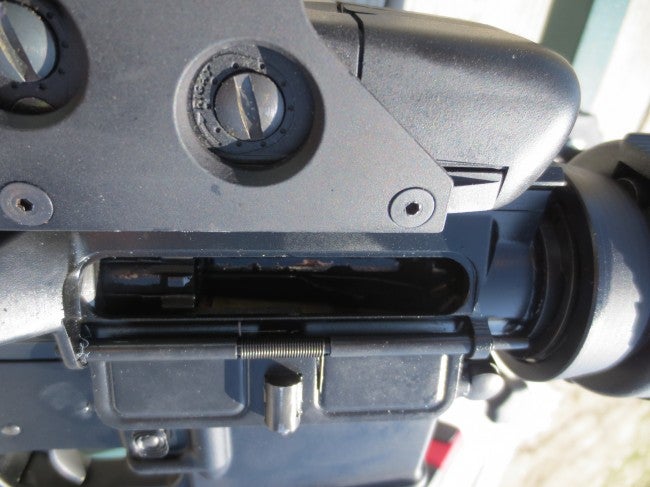
Example of a nose-dive malfunction from an overloaded 5.56 magazine. Using the provided 5.45 magazine, feeding was flawless.
The rifle handled both the 7n6 and Wolf ammunition very well. 7n6 ejected consistently to the 4 o’ clock positon. Wolf was considerably weaker, ejecting to 5:30. Interestingly, each case mouth was dented from its impact with the brass deflector in exactly the same spot.

Case mouths dimpled in the same sport across spent casings. A sign of good consistency since steel cases cannot be reloaded.
After the Range
While there is some debate on the validity of using Windex or other ammonia-based products to neutralize corrosive primer salts, I opt to err on the side of caution and spray the weapons down thoroughly prior to putting them in the gun bag. While I left the rifle in the truck overnight, it showed no signs of corrosion.
One of the main advantages of piston rifles is the ease of cleaning. I must compliment the LifeCoat treatment. The bolt, bolt carrier, and piston op-rod where as simple as dunking them in hot soapy water and drying with a paper towel. The receiver and gas block needed the same soap to neutralize the salts and require the typical AR cleaning since they are not coated.
One Predictable Issue & One Surprising One
All piston-driven AR kits suffer to one degree or another from what is known as “carrier tilt.” (Note, there are many ways to compensate for carrier tilt, but that is not in the scope of this review) In short, since the force driving the BCG is not in center-line both horizontally and vertically with the BCG, the force directs some energy in the direction of the entry force. Since the piston op rod drives hits top of the gas key, some force is directed downwards like a cantilever. This causes excess wear on the buffer tube (and in extreme cases, the buffer tube threads). The upper kit did cause some minor wear on my buffer tube after 750 rounds. Nothing major and if I were to have the upper permanently, I would get an anti-tilt buffer and buffer tube. Easy problem to solve.
The other issue was not expected. I first noticed it on the range when I pulled the BCG for a temperature test after 50 rounds (it was cold thanks to the piston system!). During the inspection, I saw some metal shavings on the cam pin. Thinking it was normal wear, I put back in for the remainder of the test. It was not until later during my first cleaning; I pulled it apart and saw a lot of shavings. Now curious, I looked in the upper receiver and saw that the steel cam pin was wearing against the upper receiver.
My guess is the spring rate for the bolt is not strong enough. I shot another 100 rounds and no additional wear was noticed. Looks like it maxed itself out.

The upper receiver. Note the slot now carved by the cam pin at the rear of the cam pin rotation area.
Wrap-Up:
The Adam’s Arms 5.45 Mid-Length Upper shoots great. It puts old surplus ammunition where you tell it with no argument. Its sturdy construction, piston driven system, and very cool coatings make this a strong contender for my dollars (retails for about $850). The problem is that it is hampered by the ATF’s rulings, which made the strongest argument for it largely moot. I would buy the 5.45 upper in a heartbeat if the ATF had not banned further 7n6 imports.
So, I have to separate the 5.45 from the review and look purely at the Adams Arms’ piston offering. Doing so yields an impressive piece of kit. The piston system significantly cools the receiver, offers no appreciable difference in recoil, adjustable gas for suppression, and only minor carrier tilt due to the one-piece BCG. You can find a kit the street for about $320, which is a good buy for those looking for its advantages. As someone who has always shot DI AR’s its hard to find fault with it other than the cash outlay. The cleaning is certainly easier!
 Your Privacy Choices
Your Privacy Choices













